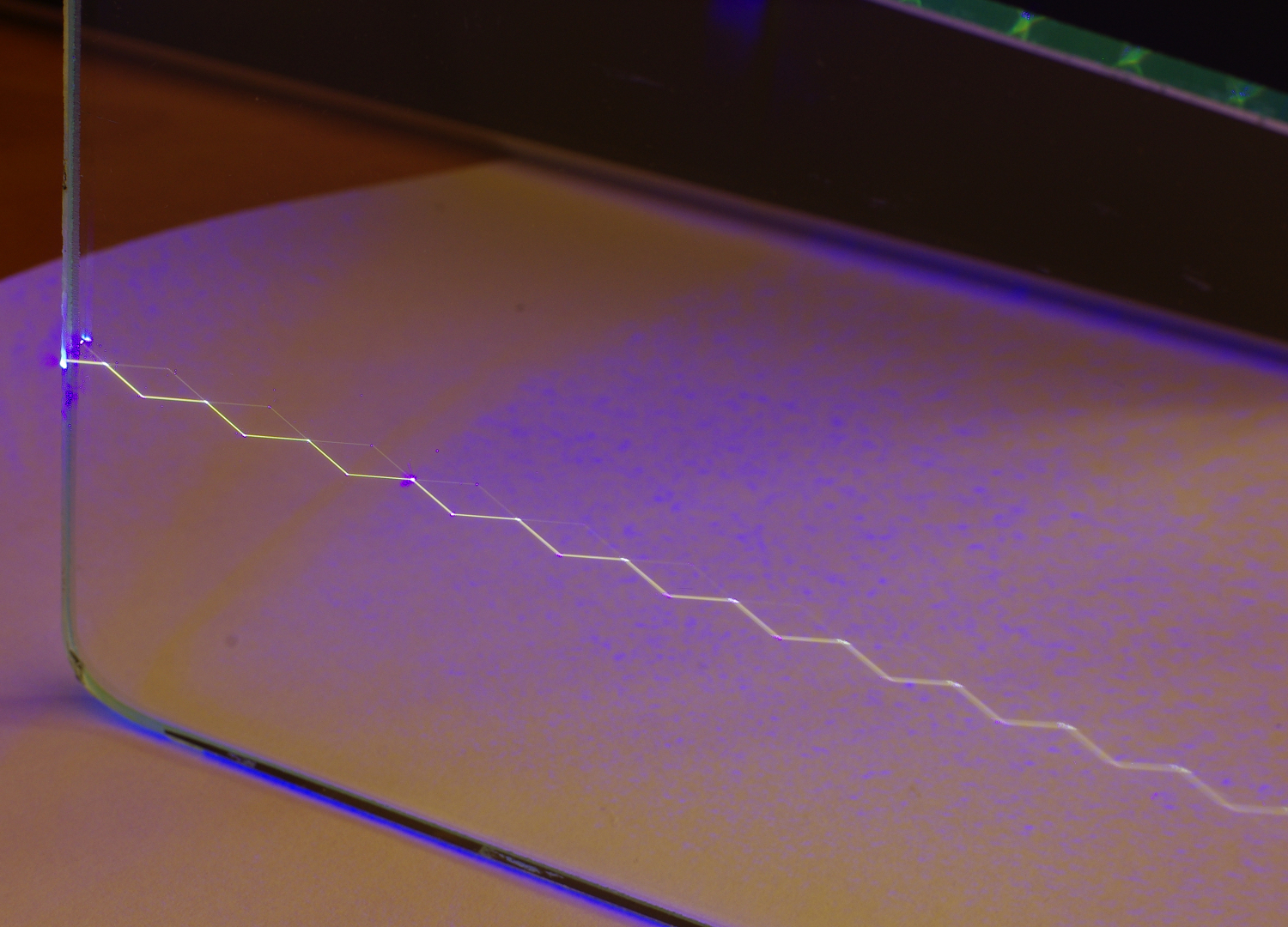|
Abbe–Koenig Prism
An Abbe–Koenig prism is a type of reflecting prism, used to invert an image (rotate it by 180°). They are commonly used in binoculars and some telescopes for this purpose. The prism is named after Ernst Abbe and Albert Koenig. The prism is made from two glass prisms, which are optically cemented together to form a symmetric, shallow Vee-shaped assembly. Light enters one face at normal incidence, is internally reflected from a 30° sloped face, and then is reflected from a "roof" (German ''Dach'') section (consisting of two faces meeting at a 90° angle) at the bottom of the prism. The light is then reflected from the opposite 30° face and exits, again at normal incidence. The net effect of the four internal reflections (two reflections are on roof plains) is to flip the image both vertically and horizontally. Since the light is reflected an even number of times, this produces a 180° image rotation (without changing the image's handedness and allows use of the prism as an ' ... [...More Info...] [...Related Items...] OR: [Wikipedia] [Google] [Baidu] |
Internal Reflection
Total internal reflection (TIR) is the optical phenomenon in which waves arriving at the interface (boundary) from one medium to another (e.g., from water to air) are not refracted into the second ("external") medium, but completely reflected back into the first ("internal") medium. It occurs when the second medium has a higher wave speed (i.e., lower refractive index) than the first, and the waves are incident at a sufficiently oblique angle on the interface. For example, the water-to-air surface in a typical fish tank, when viewed obliquely from below, reflects the underwater scene like a mirror with no loss of brightness (Fig.1). TIR occurs not only with electromagnetic waves such as light and microwaves, but also with other types of waves, including sound and water waves. If the waves are capable of forming a narrow beam (Fig.2), the reflection tends to be described in terms of " rays" rather than waves; in a medium whose properties are independent of direction, such as air, ... [...More Info...] [...Related Items...] OR: [Wikipedia] [Google] [Baidu] |
Roof Prism
A roof prism, also called a Dachkanten prism or Dach prism (from German: ''Dachkante'', lit. "roof edge"), is a reflective prism containing a section where two faces meet at a 90° angle, resembling the roof of a building and thus the name. Reflection from the two 90° faces returns an image that is flipped laterally across the axis where the faces meet. Characteristic for a roof prism is that the beam is split in half, with one half of the beam hitting first one face then the other face, while it is invert for the other half of the beam. Therefore, a roof prism can be used only with some distance to focal planes, or the "edge" of the roof would introduce slight distortions. Furthermore, the angle between the two faces has to be very close to 90°, or image quality would be degraded. The simplest roof prism is the Amici roof prism, with other common roof prism designs being the Abbe–Koenig prism, the Schmidt–Pechan prism and probably the best known being the roof pentap ... [...More Info...] [...Related Items...] OR: [Wikipedia] [Google] [Baidu] |
Schmidt–Pechan Prism
A Schmidt–Pechan prism is a type of optical prism used to rotate an image by 180°. These prisms are commonly used in binoculars as an ''image erecting system''. The Schmidt–Pechan prism makes use of a roof prism section (from the German: "Dachkante", lit. ''roof edge''). Binoculars designs using Schmidt–Pechan prisms can be constructed more compactly than ones using Porro or Uppendahl roof and Abbe–Koenig roof prisms. A Schmidt–Pechan prism is sometimes called a Pechan prism pair. Method of operation The Schmidt-Pechan is based on the Pechan prism design: Both are a composite of two prisms, separated by an air gap. Because of the air gap there are four glass/air transition surfaces. The Pechan design will invert or revert (flip) the image, depending on the orientation of the prism, but not both at the same time. For the Schmidt-Pechan design, the upper prism from the Pechan design is replaced with a Schmidt roof prism, so the Schmidt–Pechan prism can both inve ... [...More Info...] [...Related Items...] OR: [Wikipedia] [Google] [Baidu] |
Amici Roof Prism
An Amici roof prism, named for its inventor, the Italian astronomer Giovanni Battista Amici, is a type of reflecting prism used to deviate a beam of light by 90° while simultaneously inverting the image. It is commonly used in the eyepieces of telescopes as an image erecting system. It is sometimes called an Amici prism or right angle roof prism. The non- dispersive Amici roof prism should not be confused with the dispersive Amici prism. The device is shaped like a standard right-angled prism with an additional "roof" section (consisting of two faces meeting at a 90° angle) on the longest side. Total internal reflection from the roof section flips the image laterally. The handedness of the image is unchanged. The roof faces of the prism are sometimes coated to provide mirror A mirror or looking glass is an object that Reflection (physics), reflects an image. Light that bounces off a mirror will show an image of whatever is in front of it, when focused through the lens ... [...More Info...] [...Related Items...] OR: [Wikipedia] [Google] [Baidu] |
Roof Prism
A roof prism, also called a Dachkanten prism or Dach prism (from German: ''Dachkante'', lit. "roof edge"), is a reflective prism containing a section where two faces meet at a 90° angle, resembling the roof of a building and thus the name. Reflection from the two 90° faces returns an image that is flipped laterally across the axis where the faces meet. Characteristic for a roof prism is that the beam is split in half, with one half of the beam hitting first one face then the other face, while it is invert for the other half of the beam. Therefore, a roof prism can be used only with some distance to focal planes, or the "edge" of the roof would introduce slight distortions. Furthermore, the angle between the two faces has to be very close to 90°, or image quality would be degraded. The simplest roof prism is the Amici roof prism, with other common roof prism designs being the Abbe–Koenig prism, the Schmidt–Pechan prism and probably the best known being the roof pentap ... [...More Info...] [...Related Items...] OR: [Wikipedia] [Google] [Baidu] |
Porro Prism
In optics, a Porro prism, named for its inventor Ignazio Porro, is a type of ''reflection prism'' used in optical instruments to alter the orientation of an image. Description It consists of a block of material shaped like a right geometric prism with right-angled triangular end faces. In operation, light enters the large rectangular face of the prism, undergoes total internal reflection twice from the sloped faces, and exits again through the large rectangular face. When the light enters and therefore exits the glass at normal incidence, the prism is not dispersive. An image travelling through a Porro prism is rotated by 180° and exits in the opposite direction offset from its entry point. While a single Porro prism can be constructed to work as well as a roof prism, it is seldom used as such. Therefore, to reduce the cost of production for a Porro prism, the edge of the roof is usually left out. Sometimes only one small window as an entrance surface and one window as ... [...More Info...] [...Related Items...] OR: [Wikipedia] [Google] [Baidu] |
Chirality (mathematics)
In geometry, a figure is chiral (and said to have chirality) if it is not identical to its mirror image, or, more precisely, if it cannot be mapped to its mirror image by rotations and translations alone. An object that is not chiral is said to be ''achiral''. A chiral object and its mirror image are said to be enantiomorphs. The word ''chirality'' is derived from the Greek (cheir), the hand, the most familiar chiral object; the word ''enantiomorph'' stems from the Greek (enantios) 'opposite' + (morphe) 'form'. Examples Some chiral three-dimensional objects, such as the helix, can be assigned a right or left handedness, according to the right-hand rule. Many other familiar objects exhibit the same chiral symmetry of the human body, such as gloves and shoes. Right shoes differ from left shoes only by being mirror images of each other. In contrast thin gloves may not be considered chiral if you can wear them inside-out. The J, L, S and Z-shaped '' tetrominoes'' of the pop ... [...More Info...] [...Related Items...] OR: [Wikipedia] [Google] [Baidu] |
Prism (optics)
An optical prism is a transparent optical element with flat, polished surfaces that are designed to refract light. At least one surface must be angled — elements with two parallel surfaces are ''not'' prisms. The most familiar type of optical prism is the triangular prism, which has a triangular base and rectangular sides. Not all optical prisms are geometric prisms, and not all geometric prisms would count as an optical prism. Prisms can be made from any material that is transparent to the wavelengths for which they are designed. Typical materials include glass, acrylic and fluorite. A dispersive prism can be used to break white light up into its constituent spectral colors (the colors of the rainbow) as described in the following section. Other types of prisms noted below can be used to reflect light, or to split light into components with different polarizations. Types Dispersive ''Dispersive prisms'' are used to break up light into its constituent spectral col ... [...More Info...] [...Related Items...] OR: [Wikipedia] [Google] [Baidu] |
Total Internal Reflection
Total internal reflection (TIR) is the optical phenomenon in which waves arriving at the interface (boundary) from one medium to another (e.g., from water to air) are not refracted into the second ("external") medium, but completely reflected back into the first ("internal") medium. It occurs when the second medium has a higher wave speed (i.e., lower refractive index) than the first, and the waves are incident at a sufficiently oblique angle on the interface. For example, the water-to-air surface in a typical fish tank, when viewed obliquely from below, reflects the underwater scene like a mirror with no loss of brightness (Fig.1). TIR occurs not only with electromagnetic waves such as light and microwaves, but also with other types of waves, including sound and water waves. If the waves are capable of forming a narrow beam (Fig.2), the reflection tends to be described in terms of " rays" rather than waves; in a medium whose properties are independent of direction, such as ... [...More Info...] [...Related Items...] OR: [Wikipedia] [Google] [Baidu] |
Albert Koenig
Albert may refer to: Companies * Albert (supermarket), a supermarket chain in the Czech Republic * Albert Heijn, a supermarket chain in the Netherlands * Albert Market, a street market in The Gambia * Albert Productions, a record label * Albert Computers, Inc., a computer manufacturer in the 1980s Entertainment * ''Albert'' (1985 film), a Czechoslovak film directed by František Vláčil * ''Albert'' (2015 film), a film by Karsten Kiilerich * ''Albert'' (2016 film), an American TV movie * ''Albert'' (Ed Hall album), 1988 * "Albert" (short story), by Leo Tolstoy * Albert (comics), a character in Marvel Comics * Albert (''Discworld''), a character in Terry Pratchett's ''Discworld'' series * Albert, a character in Dario Argento's 1977 film ''Suspiria'' Military * Battle of Albert (1914), a WWI battle at Albert, Somme, France * Battle of Albert (1916), a WWI battle at Albert, Somme, France * Battle of Albert (1918), a WWI battle at Albert, Somme, France People * Albert (given ... [...More Info...] [...Related Items...] OR: [Wikipedia] [Google] [Baidu] |





